|
July: Summer, Surf, and Service
|
 |
Dear
,
It's a great time of year to be at Muir Beach. There are so many reasons to visit: sun, surf, summer camp...and restoration, of course! The native species we so lovingly planted last winter are growing big and strong, but so are aggressive weeds—and we could sure use your help keeping them at bay. Come enjoy summer with us—and all that Muir Beach has to offer—this month!
In This Newsletter
Welcome Amy
For the months of July and August, the Marin and San Francisco Park Stewardship teams are pulling a switch-a-roo! Amy Chong, a San Francisco intern, is trading places with Georgia for the month so both can learn about new parks, habitats, and programs. In mid-July, Georgia and Amy will swap back and Diana will head to San Francisco for a month.
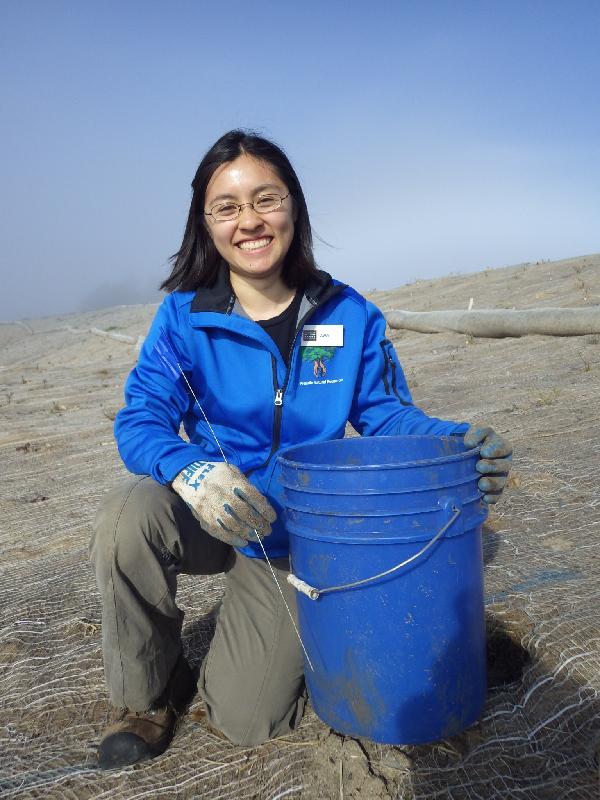 Amy has been interning since October at Lands End, the Presidio Bluffs, and Fort Funston. She has enjoyed getting to know the dedicated community volunteers who come out week after week to plant natives, pull weeds, and share stories. Highlights of her experience include eating edible invasives (ask her which are tasty) and poking at bushes looking for nesting birds. She looks forward to meeting Marin's volunteers very soon! Amy has been interning since October at Lands End, the Presidio Bluffs, and Fort Funston. She has enjoyed getting to know the dedicated community volunteers who come out week after week to plant natives, pull weeds, and share stories. Highlights of her experience include eating edible invasives (ask her which are tasty) and poking at bushes looking for nesting birds. She looks forward to meeting Marin's volunteers very soon!
Stop by and welcome Amy to Muir Beach!
Green Gulch Trail Closure and Restoration
From our neighbors at Green Gulch Farm:
Green Gulch Farm is excited to begin restoring the lower portion of Green Gulch Creek this August. The project will improve habitat for wildlife (including coho salmon) and restore some of the historic floodplain, aiding in flood management for the farm. The completed restoration will also provide enhanced aesthetic and educational opportunities for visitors to Green Gulch.
For safety reasons, a portion of the Green Gulch Trail will be closed during construction. All other trails will remain open. Access to Muir Beach from Pacific Way will not be impacted by this project. Construction will occur on weekdays from early August through October, 2014, 7 am to 4:30 pm.
Full trail access will be available during evening hours and weekends. Signs will be posted on all affected trails and at key trail junctions prior to the start of the project informing visitors of the closure. Emergency access will be maintained via a temporary road.
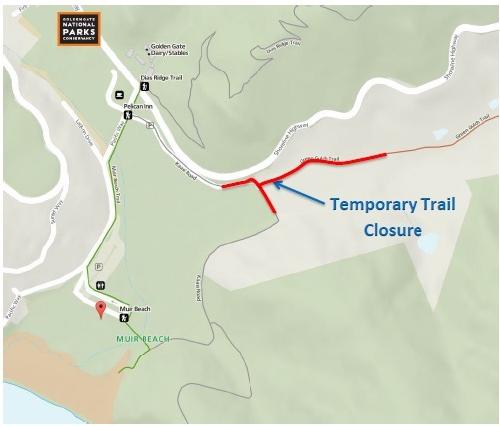
During construction, heavy equipment will be used to remove some of the existing vegetation along Green Gulch stream. Vegetation removal has been coordinated with the end of breeding bird season to prevent harm to nesting birds.
After vegetation removal, a new stream channel will be excavated, and the current channel will be filled. Large wood logs and root wads will be anchored into the stream, providing important habitat for young coho salmon. The existing bridge spanning Green Gulch Creek will be replaced with a wider, longer bridge, allowing for more riparian area and better stream flow.
During winter 2014-2015, Green Gulch staff and volunteers will restore the site with a mix of native riparian plants. If you are interested, we would welcome your participation in the restoration of the stream after the construction is completed!
If you would like more information or have questions about the project and trail access, please contact Sara Tashker, Green Gulch Farm Director, at (415) 354-0422 or
ggfdirector@sfzc.org, or project manager Tania Pollak at (415) 931-1749 or pollaktn@gmail.com.
We look forward to sharing the newly enhanced stream habitat with you for years to come!
Coveys of Quails
Chi-ca-go!
Have you heard this sound out on the trail this summer?
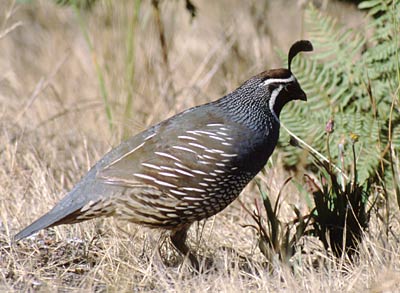 |
| Photo credit: Alan Hopkins, 2001 |
There's a good chances that if you've been hiking in the foothills, you've heard our state bird, the California quail (Callipepla californica). Although it was named our state bird in 1931, its "Chicago" call shows it has a bit of an identity crisis.
Native to western North America and southwest South America, the California quail is a popular ground-dwelling bird in the chicken family, Gallidae. Adults have a plump gray body with a scaled brown-and-white belly and sides, a black face with white "mutton-chops," and a dark plume bobbing above its forehead in both sexes.
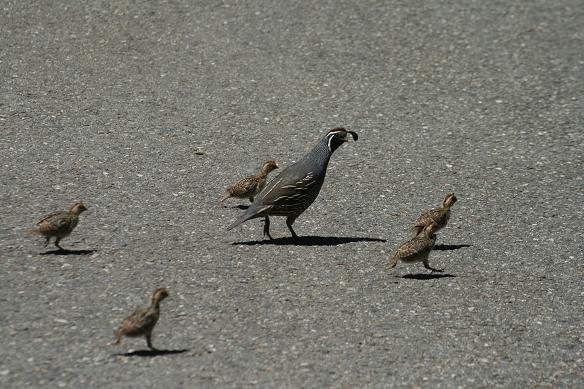 At this time of year, you will likely find a covey (group) of California quails running furiously down the trail away from you. During the breeding season (May–July), pairs are monogamous and lay 12–16 eggs. Three to four weeks after hatching, chicks are large enough to move independently and often join large family groups for protection. These coveys reach numbers of 40 or greater, with adults raising chicks in a communal fashion. There is a higher chance of survival in a large covey, as this ground-dwelling species has a large host of predators, including hawks, owls, coyotes, and bobcats. At this time of year, you will likely find a covey (group) of California quails running furiously down the trail away from you. During the breeding season (May–July), pairs are monogamous and lay 12–16 eggs. Three to four weeks after hatching, chicks are large enough to move independently and often join large family groups for protection. These coveys reach numbers of 40 or greater, with adults raising chicks in a communal fashion. There is a higher chance of survival in a large covey, as this ground-dwelling species has a large host of predators, including hawks, owls, coyotes, and bobcats.
If you'd like to increase quality habitat for California quails in Marin, join us at our regular volunteer restoration programs on Wednesday afternoons and Saturday mornings! We are weeding throughout the summer to free up resources for native plants that quail love.
If you can't make it out to Muir Beach, consider planting some native coastal scrub species on your property. It is beneficial to plant a mosaic of tree species for roosting, and a diversity of shrub species for shelter and feeding (particularly annual forbs, which have seeds quail love). Great species include big-leaf maple, hazelnut, California wild rose, lupines, fiddlenecks (Amsinckia spps), snowberry, and thimbleberry.
Share your California quail stories, photos, or questions! Feel free to talk to us at the next volunteer program or e-mail Amy at achong@parksconservancy.org.
By Amy Chong
What's Happening at Muir Beach?
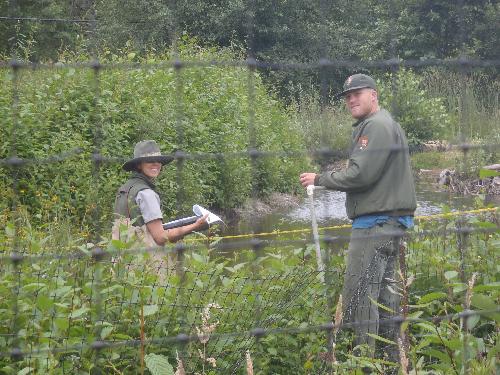
The last time you were at Muir Beach, did you see people on the wrong side of the fence? Well, before you throw some angry looks at them, check again—if they were in uniform, it’s likely they were members of our National Park Service and Golden Gate National Parks Conservancy team doing some vegetation monitoring!
Muir Beach was under active construction for the last five years, creating major disturbance in the ecosystem. Some of the construction involved removing especially invasive introduced species, including cape ivy (Delairea odorata), panic veldt grass (Ehrharta erecta), kikuyu grass (Pennisetum clandestinum), and others. These plants thrive on disturbance; they will often reestablish and quickly crowd out native plants if not managed carefully. Vegetation monitoring allows restoration managers to track the effectiveness of the restoration over time.
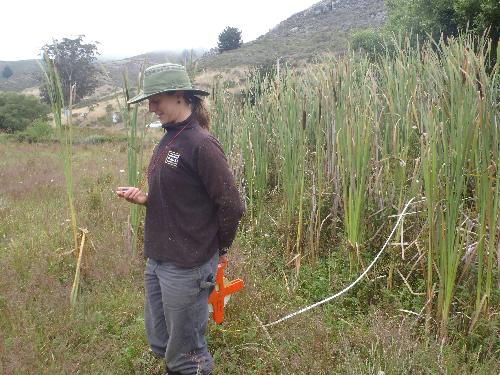 So what does vegetation monitoring entail? First, the monitoring team finds pre-determined starting points using Global Positioning Systems (GPS), the same technology that gives you directions in your car. Once the team finds the point, one member uses a compass to find the angle of the transect. So what does vegetation monitoring entail? First, the monitoring team finds pre-determined starting points using Global Positioning Systems (GPS), the same technology that gives you directions in your car. Once the team finds the point, one member uses a compass to find the angle of the transect.
After the team finds the angle of the transect, one member pulls a 100 meter tape measure along the line, straight through the vegetation. The team identifies all invasive species, especially previously established “target” species, in a one meter quadrat, or square, at eight meter intervals along the tape.
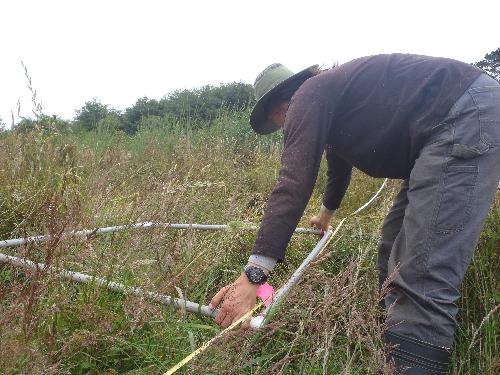 There are transects, or lines, that run through every kind of habitat at Muir Beach, covering the entire site. When all transects are completed, restoration managers can use the data to get a good sense of the frequency of different invasive species on site. They compare their findings to previous years and can gauge the effectiveness of their management methods—and if they need to change. There are transects, or lines, that run through every kind of habitat at Muir Beach, covering the entire site. When all transects are completed, restoration managers can use the data to get a good sense of the frequency of different invasive species on site. They compare their findings to previous years and can gauge the effectiveness of their management methods—and if they need to change.
This is the fifth year of monitoring at Muir Beach. Since 2009, 15 of the target species have decreased in frequency, including nine species that are now only found in 5% of quadrants. The decreases are the results of the combined efforts of staff, interns, contractors, and volunteers working hard to restore this site.
Everything we do at Muir Beach is to preserve our resources: natural, cultural, and recreational. Take a moment to ask what’s going on! The national parks are YOUR parks, and we are happy to answer questions about the work being done, especially when it looks a little strange!
By Diana Feldmann
July Program Changes, Updates, and Cancellations
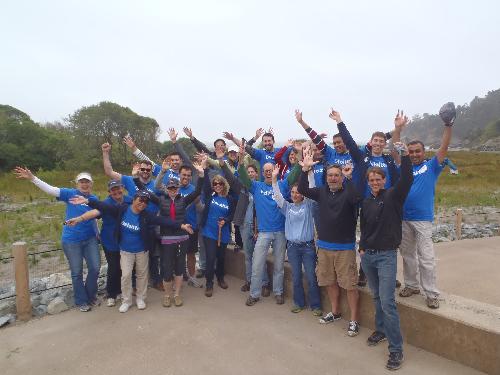 |
Thank you, Deloitte, for caring for Muir Beach!
Photo credit: Naomi LeBeau |
Habitat Restoration Programs
•No changes or cancellations
Marin Park Stewardship
•July 5: Drop-in program was cancelled for holiday weekend.
Marin Headlands Nursery
•July 5: Drop-in program was cancelled for holiday weekend.
Tennessee Valley Nursery
•No changes or cancellations
Redwood Creek Nursery
•No changes or cancellations
Volunteer Program Information and Work Day Schedules
Habitat Restoration Programs
Habitat Restoration Team
Tuesdays, 10 am-Noon, and Sundays, 9:30 am–2:30 pm. Habitat Restoration Team (HRT) hosts work days throughout the Golden Gate National Parks in Marin County. For more information, please visit our website.
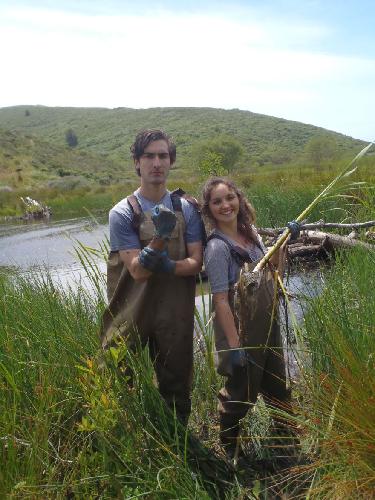 |
Pulling cattails to help water flow
Photo credit: Georgia Vasey |
Marin Park Stewardship
Saturdays, 10 am–1 pm, and Wednesdays, 1–4 pm, are drop-in volunteer days in the lower Redwood Creek Watershed. Meet at the Muir Beach parking lot by the pedestrian footbridge. Visit our website for directions and more information, or e-mail Georgia.
Marin Nursery Programs
Redwood Creek Nursery
Wednesdays, 10 am–1 pm. To register, visit our website.
Marin Headlands Nursery
Wednesdays, 1–4 pm and Saturdays, 9 am–Noon. To register, visit our website.
Tennessee Valley Nursery
Tuesdays, 1–4 pm (this follows a morning field program). To register, visit our website.
Contact our volunteer management team at (415) 561-3044 or volunteer@parksconservancy.org, or visit www.parksconservancy.org/volunteer for more information on volunteering in the Golden Gate National Parks.
Other Ways To Get Involved
- Bzzz...grab your camera and help to protect and identify bumble bees. Conservation efforts for this familiar insect are more important than ever as habitat loss, insecticide use, disease, and climate change threaten their populations. "Bee" a part of the citizen science campaign to gather more information about bumble bees by visiting BumbleBeeWatch.org.
- Seen any river otters at Muir Beach or Muir Woods? Help the folks at the River Otter Ecology Project by detailing your findings here.
- The endangered coho salmon call Redwood Creek their home. Learn more about coho ecology and related events here.
- Green Gulch Farm, next door to Muir Beach, is looking for volunteers to help participate in habitat restoration projects around the farm. These projects occur on the second Sundays of most months. To find out more information contact Sukey Parmelee at sukey.parmelee@sfzc.org.
- Check out Park Academy classes taught by different park professionals working all over the Bay Area.
- Our stream restoration neighbors to the north at Turtle Island Restoration Network are doing great work as well. Check out what their SPAWN program is working on here.
Thank you again for your support, and hope to see you in our parks soon!
Sincerely,
Naomi, Diana, Amy, and Sofia on behalf of Marin’s Park Stewardship and Park Nurseries teams
"Wherever you go, no matter what the weather, always bring your own sunshine."
~Anthony J. D'Angelo 
|